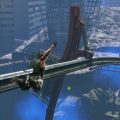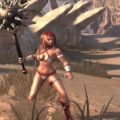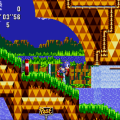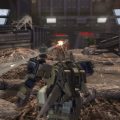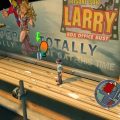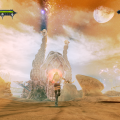- Sonic Generations
- Sonic the Hedgehog
- Sonic the Hedgehog 2
- Sonic CD
- Sonic the Hedgehog 3
- Sonic & Knuckles
- Sonic the Hedgehog 4
- Sonic Mania
- SegaSonic The Hedgehog
- Sonic The Fighters
- Sonic 3D Blast
- Knuckles’ Chaotix
- SegaSonic Bros.
- Sonic the Hedgehog (8-bit)
- Sonic the Hedgehog 2 (8-bit)
- Sonic Chaos
- Sonic the Hedgehog Triple Trouble
- Tails’ Skypatrol
- Tails Adventures
- Sonic Labyrinth
- Sonic Drift
- Sonic Drift 2
- Sonic Blast
- Sonic R
- Murder of Sonic the Hedgehog, The
- Sonic Advance
- Sonic Advance 2
- Sonic Advance 3
- Sonic Rush
- Sonic Rush Adventure
Your experience with Sonic Generations will depend on whether or not you are a fan of the Sonic the Hedgehog series going into the game. If you are, Sonic Generations is a celebration of everything that makes the franchise brilliant, a nostalgic trip through some of the blue blur’s greatest highlights, and a reminder of just how undeniably good Sonic games can be when done right. If you’re not a fan of the series going into Sonic Generations, then after playing it, you probably will be.
Released in 2011, Sonic Generations was conceptualized as a celebration of the franchise’s 20th anniversary. The game begins with Sonic’s closest friends (and Espio) all coming together to throw a surprise birthday party for their heroic hedgehog pal. The festivities are interrupted when a titanic behemoth exuding dark energy arrives via a dimensional portal and abducts Sonic’s friends (and Espio) with various other portals. At the same time, Classic Sonic – just as he appeared in 1991; smaller, mute, and having not yet learned how to boost-dash – has his own encounter with this fearsome foe. When Sonic (well, both Sonics, although they haven’t met yet,) wakes up, the world has been drained of color, and the only way to restore life and rescue his friends is for Sonic and Sonic to travel through nine levels, with one ‘classic’ and one ‘modern’ iteration each, all based on his previous adventures. Or, from Classic Sonic’s perspective, future adventures.
Much like Sonic Colors, Sonic Generations began development almost immediately after the release of Sonic Unleashed in 2008, and uses the same engine, which is wild to consider when a level based on Colors was brought back and improved upon in Generations, even though Colors had only released less than a year prior (albeit only less than a year by ten days.) The games that Sonic Generations pay homage to can be handily split into the Classic Era of Sonic the Hedgehog, Sonic 2 and Sonic 3 & Knuckles, the Dreamcast (and Dreamcast-adjacent) Era of Sonic Adventure, Sonic Adventure 2 and Sonic Heroes, and the Modern Era of Sonic the Hedgehog (2006), Sonic Unleashed, and Sonic Colors. Each area also comes with an appropriate mini-boss (Metal Sonic, Shadow and Silver) and a climactic boss fight against one of the most famous opponents of the time; Dr Robotnik’s Death Egg Robot from Sonic 2 for the classic era, Dr Eggman’s Egg Dragoon from Sonic Unleashed for the modern era, and the irreplaceable Perfect Chaos fight from Sonic Adventure to cap off the Dreamcast era.
Act One of each level is the classic version, played by the smaller, less-experienced Sonic. Accurate to the time, Classic Sonic can charge up a spin-dash, but that’s about it; there’s no boost or homing attacks to be found, and while the environments Sonic moves through are rendered in beautiful 3D, Sonic can only move on a predetermined 2D plane. Act Two hands the reins to Modern Sonic, who explores equally visually-stunning 3D levels with a greater amount of control, the ability to boost through enemies and obstacles alike, and a reliable homing attack that can be used to destroy foes – often while using them to cross a gap or reach new areas – and also lock on to interactable targets in the environment, like springs or pulleys. Because of this, Classic Sonic’s levels are easier in general, but during extended play sessions, it is a practically a guarantee that at some point, you will forget which Sonic you are controlling, and try to boost or launch a homing attack as Classic Sonic to no avail, or try to charge up a spin-dash as Modern Sonic and end up boosting yourself directly into a pit.
Each level also comes with ten challenge acts – five each for Classic and Modern Sonic – which feature a variety of trials ranging from simple time attacks, to completing a difficult section of a level with only one ring, or avoiding an abundance of enemies on a modified version of the level, or fulfilling a bonus task with the help of an assist character, like Amy giving you some extra height with her Piko Piko Hammer, or Knuckles digging in the ground for buried medallions. These are all fairly standard, but still simple and fun, and they unlock concept art, music and skills.
Regarding the selection of the levels themselves, you also have to admire the sheer chutzpah of Sonic Team to not just bring back the safe levels that everyone already loved, but revamp a level from Sonic the Hedgehog (2006), a game widely-considered one of the worst in the history of the franchise, and not only acknowledge it as a noteworthy part of Sonic’s history regardless, but also to transform its signature level – Crisis City – into one of Sonic Generations’ best levels, 2D or 3D. And that’s high praise indeed when a case could be made that practically any level in the game is one of the best levels. The level-design is at an all-time high for the series, in terms of not only being incredibly fun to play, but also as visually appealing as possible, with a plethora of iconic locations presented more beautifully than you have ever seen them before
Far from just coasting on nostalgia, the levels are filled to the brim with creative expansions on what made these levels so memorable to begin with. Everyone loves City Escape, the opening level to Sonic Adventure 2, which begins with Sonic snowboarding – minus the snow – down the streets of Central City, and concludes with a brief chase from a GUN Military Truck. It’s a fun set piece to end the level, but all you really need to do to escape is hold ‘down’ for fifteen seconds. In Sonic Generations, the same truck frequently menaces Classic Sonic in Act One, destroying platforms, deploying enemies, and loudly hunting him throughout, and in Act Two, the chase sequence has been greatly extended, and the truck is now armed with three extendable arms wielding circular sawblades that you have to avoid. And when Sonic escapes by running up a wall? The truck reveals that it’s also been outfitted with rocket thrusters, which allow it to fly up the wall and continue to chase you. This is just one example, but the game is packed with imaginative additions like this.
Each level is also full of details for dedicated fans of the series; going back to City Escape, eagle-eyed players may spot a wanted poster for Fang the Sniper, who menaced the blue blur all the way back in Sonic the Hedgehog Triple Trouble on the Game Gear, as well as missing posters for Mighty the Armadillo and Ray the Squirrel, describing them as ‘missing since 1993,’ which coincides with their debut in the isometric arcade game SegaSonic the Hedgehog, and aside from Mighty the Armadillo making a brief appearance in Knuckles Chaotix, neither had been seen since. Their fans need not worry though, as they both made playable reappearances in Sonic Mania Plus in 2018.
Speaking of deep dives into more obscure Sonic games, the soundtrack to Sonic Generations is incredibly thorough. There are the standard tracks that everyone would expect – ooh, Green Hill Zone, what a surprise – but also tracks from Sonic Spinball, Sonic R, Sonic Battle, Sonic Rivals, the entire Sonic Advance series, and once unlocked – usually by finding red rings hidden across the modern and classic levels – you have the option to swap the original music of any level, with music of your choosing. Although you probably won’t be too tempted to try this, because for the standard music of every level, Sonic Team brought back nearly all of the original composers and artists to rescore their work. And yes, this includes Crush 40, who redid several songs from the Sonic Adventure games, including Escape to the City.
Those red rings hidden across every level – a returning feature from Sonic Colors – also serve to nudge the player into replaying the levels multiple times, which diminishes one of the most frequent flaws in Sonic titles. There will almost always be a moment when Sonic is dashing through the stage, and the player realizes that they just missed a secret or an alternate path, because the speeds at which they were travelling only allowed them a few milliseconds of reaction time to this new information. But with the red rings to collect, this is no longer a test of your reflexes, but a test of your memory; the next time you play this level – and even without the collectible red rings unlocking numerous rewards, you’re going to want to replay the levels – then just remember where this alternate path is, and don’t miss it this time. This sounds like a very basic change – and it is! – but this genuinely improved the way a lot of people approach Sonic games; with less frustration towards not being given a chance to react in time, and more of a ‘Challenge accepted, I’ll get you next time!’ mindset.
Aside from soundtracks and concept art, collecting all of these red rings will unlock various abilities in Omachao’s stall, located at the start of the hub world. You can purchase these skills – with points that you earn by playing the levels, not real-moneymicrotransactions, don’t worry –to give you an edge on any levels you’re struggling on, or just to have fun, as is the case with ‘Collect 50 rings and turn into Super Sonic.’ Bonus rings when restarting after a death, faster acceleration and the ability to slow down more precisely are available to both Sonics. Modern Sonic’s exclusive upgrades generally focus on the boost gauge – increasing its size, enabling it to be refilled by collecting rings or destroying enemies, or just passively regenerating over time – while Classic Sonic can start a level with one of several recognizable shields, such as the Thunder Shield which allows double-jumps, and the Aqua Shield which enables bounce-jumps, and allows Sonic to breathe underwater indefinitely. It takes up your entire allotted ‘Skill Points’ allowance, so you can’t equip anything else at the same time, but you can even finally give Classic Sonic the ability to do a homing attack.
The 3DS version of Sonic Generations is also worth singling out, because Sonic Team decided that rather than just trying to port the console version to a handheld, they would create an entirely new game from scratch instead, bringing back different levels like Casino Night Zone from Sonic 2, Emerald Coast from Sonic Adventure, and diverging from the console version even more by revisiting the history of Sonic’s handheld titles, with levels from Sonic Rush and the DS version of Sonic Colors. The 3DS game is generally regarded as not quite as good – it was limited to just seven levels, still with a Classic and Modern variant each, so fourteen in total.
It’s disappointing that the Sonic Advance trilogy didn’t get a level brought back, but Sonic Generations also has a very active modding community on PC, so if your favorite level wasn’t brought back, someone else has almost certainly made a version of it by now. An updated remaster, Sonic X Shadow Generations, is planned for release in October 2024, adding an entirely new campaign for Shadow, but it’s a testament to how fantastic the original game is that so many players are just happy to have an excuse to play through Sonic Generations again.
At the end of Sonic Generations, Modern Sonic wishes Classic Sonic good luck as he heads back to his own 16-Bit era timeline with an encouraging “Hey Sonic, enjoy your future! it’s going to be great!” This line has been the subject of moderate derision due to the… mixed reception of modern Sonic titles, but Generations proves that this was not an empty promise. Because once Classic Sonic returns to his debut in 1991, he only has to wait another twenty years for Sonic Generations to come out. And no matter what you think of the franchise as a whole, there are plenty of worse futures than that.










